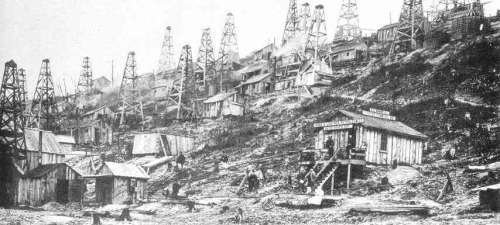peashooter85:Pithole Come and Gone — The Great Pennsylvania Oil Rush,As someone born and raised in N
peashooter85:Pithole Come and Gone — The Great Pennsylvania Oil Rush,As someone born and raised in Northwestern Pennsylvania I was always fed the legend in school that in 1859 Col. Edwin Drake drilled the first artificial oil well. While I know now that is not true, there are many who drilled wells in the 19th century, not to mention the Chinese who drilled for oil as far back as ancient times, it was Drake’s accomplishment that would create the birth of the modern oil industry. As a result of Drake’s discovery, hundreds of thousands of prospectors from around the world flocked to Northwestern Pennsylvania seeking opportunity and riches. Most settled in the area of Venango and Crawford County, founding towns that exist today such as Oil City, Franklin, and Titusville. The cities and towns that were created as a result of the Pennsylvania Oil Rush were much like the gold and silver boom towns of the old west. Populations exploded rapidly, but when the riches ran out, all that was left was a series of empty ghost towns. One of the most famous of the PA oil region was Pithole. Located in between Vengango and Forest Counties, Pithole was a boomtown that was often compared to Dodge City in the West. In January of 1864 Pithole was founded when an oil prospector named Isiah Frazier struck black gold. By July 2,000 people settled in Pithole, by Novemeber that number had exploded to 15,000 people. By Christmas day of 1864, Pithole was home to around 25,000 immigrants.A bustling boomtown, Pithole sported 54 hotels, 3 churches, a number of stores, and numerous saloons, gambling dens, and brothels. In addition, the landscape would have been littered with scores, if not hundreds of oil wells. Most residents of Pithole were oil prospectors who were there on a temporary basis, moving in to drill a claim, and going home when they either busted out or struck a fortune. Along with oilers were a number of other people such as merchants, lawyers, land speculators, doctors, craftsmen, and skilled people necessary for a healthy town. The boom also brought a number of less desirable people such as gamblers, prostitutes, outlaws, gangsters, thieves, and con artists.The fall of Pithole began when in early 1866, a mere two years after its founding, oil wells in the town hit peak production. By spring of the same year financiers began to flee pithole in search for greener pastures. When the financiers left, so did the oilers, and when the oilers left, so did everyone else. By December of 1866, the population of Pithole dropped to only 2,000. By 1870 only 237 lived in Pithole, and by 1880, it was an abandoned ghost town. Unlike western ghost towns, where the town is preserved by dry conditions, Pithole was quickly overrun by forest and foliage. Today all that remains of Pithole are the foundations of streets and buildings, protected by the state as a part of Oil Creek State Park. Pithole was not unique among PA Oil Rush boomtowns, as dozens of other boomtowns suffered similar fates and were quickly wiped off the map. In 1891 Pennsylvania oil production peaked at 31 million barrels. Soon afterword, other oil regions such as Ohio, California, Wyoming, Oklahoma, Texas, the Gulf Coast, and Alaska would draw oil booms of their own. By 1901, the PA Oil Rush had moved on, leaving dozens of empty boom towns like Pithole with it. -- source link


